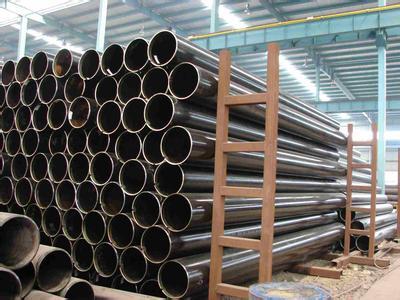
ERW Pipe Full Form
ERW pipe is a "high-frequency electric resistance welded steel pipe". Different from the welding process of ordinary welded pipes, ERW high-frequency welded pipe is a hot-rolled coil formed by a forming machine. The skin effect and proximity effect of high-frequency current are used to make the pipe blank The edges are heated and melted, and pressure welding is performed under the action of extrusion rollers to achieve production. The weld seam is formed by melting the base material of the steel strip body, and its mechanical strength is better than that of ordinary welded pipes.

Welded pipes are round pipes made of steel plates or strips as raw materials and processed and welded through multiple processes. They are divided into high-frequency resistance welded pipes (ERW welded pipes), straight seam submerged arc welded pipes (LSAW pipe), and spiral welded pipes (SSAW).
The production process of ERW pipe is:
Slitting - uncoiling - strip leveling - head and tail shearing - strip butt welding - loop storage - forming - welding - deburring - sizing - flaw detection - flying cutting - initial inspection - steel pipe Straightening - pipe section processing - hydraulic test - flaw detection - printing and coating - finished product.
The main factors affecting straight seam resistance welded steel pipes:
Enter the heat, welding pressure, welding speed, opening angle, resistor placement, etc.
Application occasions of ERW welded pipe:
It is mainly used for boilers, automobiles, ships, light-structure door and window steel for construction, furniture, various agricultural machinery, scaffolding, wire conduits, high-rise shelves, containers, etc.
ERW Pipe vs Seamless Pipe:
The biggest difference between ERW steel pipes and seamless steel pipes is that ERW has a weld seam, which is also the key to the quality of ERW steel pipes.
With the development of modern ERW steel pipe production technology and equipment, the seamlessness of ERW steel pipes has been solved satisfactorily. Some people divide the seamlessness of ERW steel pipes into geometric seamlessness and physical seamlessness.
Geometric seamlessness is to remove the internal and external burrs of ERW steel pipes. Due to the continuous improvement and improvement of the structure of the internal burr removal system and the cutting tools, the removal of internal burrs in large and medium-diameter steel pipes has been better handled. The internal burr can be controlled at about -0.2mm~O.5mm.
Physical seamlessness refers to the difference between the metallographic structure inside the weld and the base metal, which leads to a decrease in the mechanical properties of the weld area. Measures need to be taken to make it uniform and consistent.
The high-frequency welding heat process of ERW steel pipes causes a temperature distribution gradient near the edge of the tube blank, and forms characteristic areas such as melting zone, semi-melting zone, overheated structure, normalizing zone, incomplete normalizing zone, and tempering zone. In the superheated zone structure, due to the welding temperature above 1000°C, the austenite grains grow rapidly, and a hard and brittle coarse grain phase will be formed under cooling conditions. In addition, the existence of temperature gradient will generate welding stress. In this way, the mechanical properties of the weld area are lower than those of the base metal. The physical seamlessness is achieved through the local conventional heat treatment process of the weld, that is, using a medium frequency induction heating device to heat the weld area to AC3 (927°C), and then conduct 60m Air cooling process with length and speed of 20m/min, followed by water cooling when necessary. The use of this method achieves the purpose of eliminating stress, softening and refining the structure, and improving the comprehensive mechanical properties of the welding heat-affected zone.
So far, the world's advanced ERW units have generally adopted this method to process welds, and have achieved good results. High-quality ERW steel pipes not only cannot identify the welding seam, but also have a welding seam coefficient of 1, achieving a match between the structure of the welding seam area and the base material.
Read more: Why are Seamless Pipes more Expensive than Welded Pipes?
- 【Prev】 : What are the Ways to Connect Pipe Fittings to Pipes?
- 【Next】 : Steel Pipe Length Range


